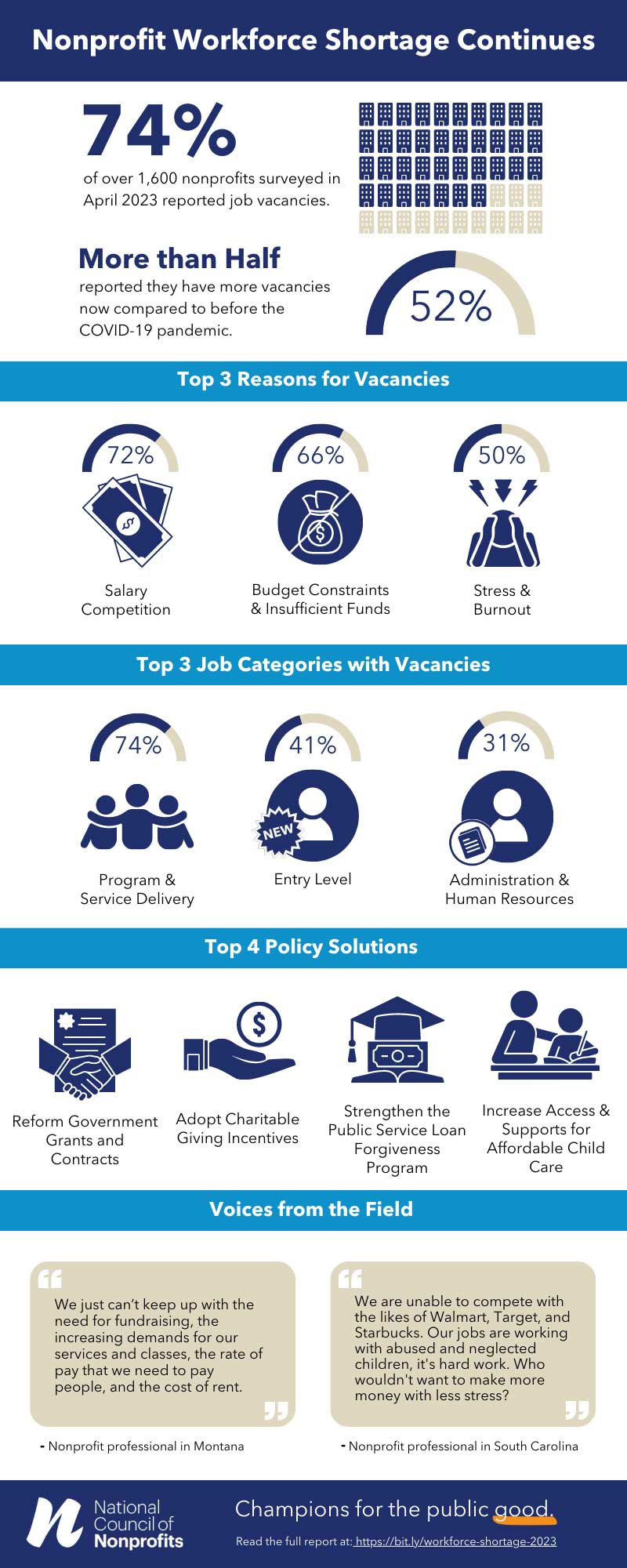
In April 2023, the National Council of Nonprofits conducted a nationwide survey to gather the most up-to-date and comprehensive data on the nonprofit workforce. When nonprofits face challenges in hiring sufficient staff to deliver essential services, the community and public are directly impacted.
In April 2023, the National Council of Nonprofits conducted a nationwide survey to assess the nonprofit workforce. The survey revealed that a shortage of employees in nonprofit organizations is causing significant challenges for communities, with longer waiting lists, reduced services, and in some cases, the complete elimination of critical services. When nonprofits cannot hire the necessary staff, the public suffers, losing access to essential services like food, shelter, and mental health care.
The report, based on over 1,600 responses from all 50 states and the District of Columbia, highlights the continued struggle of nonprofits to fill vacancies. It also provides data from various state associations and nonprofits, offering practical solutions and policy recommendations to address the workforce crisis.
Why It Matters
When nonprofits cannot secure enough staff, their communities face significant consequences. Staffing shortages in essential services mean families and individuals are unable to access life-saving support. This report highlights the importance of nonprofits raising awareness about these challenges, collecting data, and advocating for public policy changes to protect communities and ensure vital services are provided.
Key Findings
- Job Vacancies: Nearly three in four nonprofits (74.6%) reported job vacancies.
- Increased Vacancies Since the Pandemic: Over half of nonprofits (51.7%) reported more vacancies compared to before the COVID-19 pandemic, and almost 30% (28.1%) have longer waiting lists.
- Vacancies in Key Roles: Nonprofits have the highest vacancies in positions that interact directly with the public, with 74.0% reporting open program and service delivery roles.
- Salary and Budget Challenges: The top barriers to recruitment include salary competition (72.2%) and budget constraints (66.3%), followed by stress and burnout (50.2%) and issues with government grants and contracts (20.6%).
- Charitable Giving: Seven out of ten nonprofits (70.5%) anticipate a decrease or no change in charitable giving in 2023, with 68.7% expecting a decrease or no change in the number of donors.
The data underscores that workforce shortages continue to hurt nonprofits’ ability to deliver services, which affects the broader community.
Barriers to Recruiting and Retaining Staff
- Salary Competition: 72.2% of respondents cited salary competition as a major challenge.
- Budget Constraints: 66.3% mentioned budget limitations as a factor affecting their ability to hire.
- Burnout: Over half (50.2%) identified stress and burnout as key contributors.
- Government Grants and Contracts: 20.6% reported challenges related to government funding processes.
- Childcare Availability: 14.6% cited a lack of affordable childcare as a barrier to recruiting and retaining staff.
Practical and Public Policy Solutions
To address these challenges, nonprofits have implemented various solutions, such as offering more flexible work arrangements or adjusting staffing structures to maximize efficiency. The report also calls for public policy reforms, particularly in government grants and contracts, to help alleviate financial and operational pressures on nonprofit organizations.
Ultimately, this crisis highlights the need for both practical solutions within the nonprofit sector and systemic changes in public policy to ensure nonprofits can effectively serve their communities.


![The Future of Jobs Report 2025 [Infographic] hero-image-the-future-of-jobs-report](https://www.skillzme.com/wp-content/uploads/2025/02/hero-image-the-future-of-jobs-report-200x200.jpg)
![United Arab Emitaes (UAE) Population Statistics 2024 [Infographic] hero-image-UAE-Population-Statistics-2024](https://www.skillzme.com/wp-content/uploads/2024/11/hero-image-UAE-Population-Statistics-2024-200x200.jpg)
![Understanding the role of AI in Cyber Security [Infographic] hero-image-State-of-AI-Cybersecurity-2024](https://www.skillzme.com/wp-content/uploads/2024/11/hero-image-State-of-AI-Cybersecurity-2024-200x200.jpg)


Recent Comments